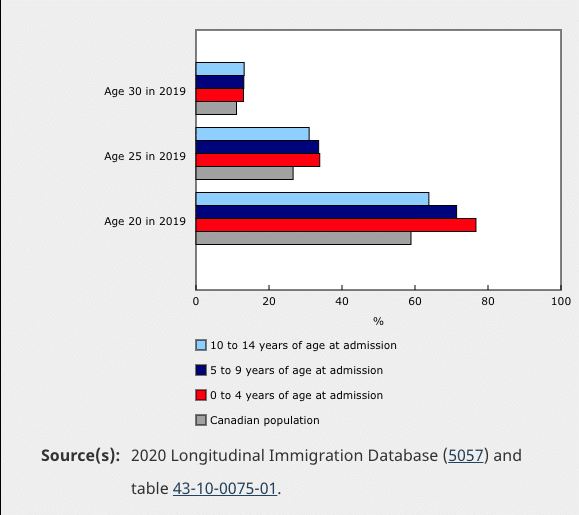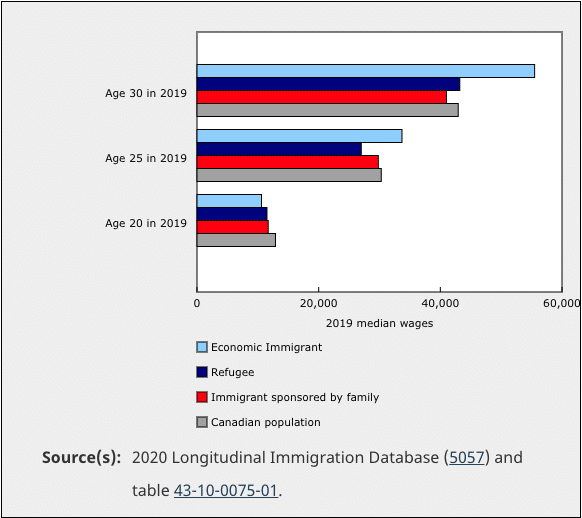Immigrant children become more educated and higher paid than Canadian average: study
A new Statistics Canada study shows immigrant children have a higher postsecondary education rate, and make more money after their mid-20s than the overall Canadian population.
The study is based on 2019 income tax data from the Longitudinal Immigration Database (IMDB), which provides a long-term perspective on how immigrant children integrate into Canadian society.
The results show immigrants who came to Canada as children participated in postsecondary education more often than the Canadian population as a whole, with those admitted at younger ages participating the most. Also, children admitted as economic immigrants fared better than the overall Canadian average from age 25 on. Then by age 30, children of sponsored and refugee families had median wages comparable to the overall population. These results were similar to what Stats Can found in a study for the 2018 tax year.
Data from 2019 will contribute to baseline estimates in preparation for future research on the impact of the COVID-19 pandemic on immigrant children, their adjustment period, and their long-term socioeconomic outcomes in adulthood.
Discover if You Are Eligible for Canadian Immigration
Immigrant kids participation in post-secondary studies
Kids who immigrated to Canada before age 15 had particularly high rates of postsecondary participation. The participation rate was about 70% for 20-year-old immigrants admitted as children, compared with about 59% of the overall Canadian population. At age 25, the participation rate was about 33% for immigrants admitted as children, and about 27% for the overall Canadian population.
As immigrant kids landed at older ages, their participation in postsecondary education generally decreased. In 2019, nearly 77% of 20-year-old immigrants admitted before age five went into postsecondary studies. The participation rate dipped to about 72% for those admitted between ages five to nine, and nearly 64% for those admitted between the ages of 10 to 14 years. Various factors affect postsecondary participation, such as academic preparation and knowledge of official languages.
Postsecondary participation among child immigrants also appears to be related to their parents' socioeconomic characteristics. As a result of Canada's selection process for economic immigrants, most of these parents already have some postsecondary education at the time of their admission. Because of this, immigrants admitted as children of economic immigrant families have much higher postsecondary education participation than children admitted under other immigration categories, especially during early adulthood.
Children of economic immigrants saw a postsecondary participation rate of more than 75% at age 20, compared to children of sponsored families at about 61%, and the overall population of Canada's rate at nearly 59%. Refugee children had the lowest participation in postsecondary education at a rate of nearly 54%.
2019 postsecondary education participation for immigrants admitted as children

Economic class children report higher earnings
At age 20, immigrants who came to Canada as children had lower median wages ($10,900) than the overall Canadian population ($12,900). The study suggests this is because at this age, immigrants were most likely enrolled in postsecondary studies. At age 25, median wages of immigrants went up to $31,500, surpassing the overall Canadian population at $30,290.
However, at age 25, economic immigrant children had about 11% higher median wages ($33,700) than the overall Canadian population ($30,290) of the same age. Median wages of 25-year-old immigrants who came to Canada as children of sponsored families were lower than the overall Canadian average.
At age 30, immigrants admitted as children of economic immigrants had median wages of $55,500, about 29% higher than the overall Canadian population at $42,940. Children admitted with refugee families were making slightly more than the Canadian average at $43,200, and children of sponsored families were making about $41,000.
2019 median wages of immigrants admitted as children by age and immigration category

Discover if You Are Eligible for Canadian Immigration
© CIC News All Rights Reserved. Visit CanadaVisa.com to discover your Canadian immigration options.
- Do you need Canadian immigration assistance? Contact the Contact Cohen Immigration Law firm by completing our form
- Send us your feedback or your non-legal assistance questions by emailing us at media@canadavisa.com






